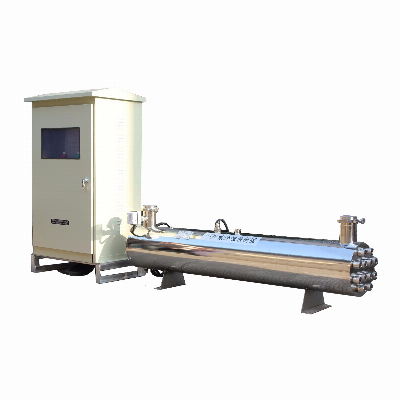UV disinfection and sterilisation for domestic and industrial water
treatment Major Benefits of UV Disinfection
Ultraviolet disinfection has many advantages over alternative
methods. Unlike chemical biocides, Ultraviolet disnfection and
sterilization techniques do not introduce toxins or residues into
process water and does not alter the chemical composition, taste,
odour or pH of the fluid being treated. This is one of the most
important aspects of all ultraviolet
disinfection systems. This feature is especially
important in the food and dairy industry where the chemical dosing
of incoming process water can compromise flavours and changes the
physical chemical properties of the food products. Ultraviolet UV
treatment can be used for primary water disinfection or as a back
up for other water purification methods such as carbon filtration,
reverse osmosis or pasteurisation. As UV has no residual effect,
the best position for a treatment system is immediately prior to
the point of use. This ensures incoming microbiological
contaminants are deactivated and there is a minimal chance of
post-treatment contamination. Many users install UV systems after
filter beds and storage tank outlet valves to reduce the likelihood
of contamination from these sources. A typical UV disinfection
system consists of an ultraviolet UV lamp housed in a protective
quartz sleeve, which is mounted within a cylindrical stainless
steel chamber. The liquid to be treated enters at one end and
passes along the entire length of the chamber before exiting at the
other end. Virtually any liquid can be effectively treated with UV,
including mains water, filtered process water, milk, sugar syrups
and effluent. Ultraviolet disinfection systems have many uses
in commercial, industrial and domestic applications. Ultraviolet
lamps, germicidal bulbs and ultraviolet disinfection
lamp are widely accepted in applications such as: Water
purification, UV disinfection and sterilisation for domestic and
industrial water treatment. Domestic, commercial and industrial
wastewater treatment Municipal sewage and wastewater treatment
Aquaculture, fish farming, oyster farming water treatment,
disinfection and purification Disinfection and sterilisation of
potable drinking water Disinfection and sterilisation of industrial
process water Curing of glues and adhesives Curing of inks on
continuous web, screen printing, lithographic and large format
printing processes Air purification in ducting of factories,
food-processing plants, nursing homes, and hospitals Ozone
generation Surface disinfection, food conveyor sterilisation
Principle of Operation Ultraviolet disinfection
systems typically utilize thin cylindrical bulbs capable of
generating narrow band wavelength UV light in the 254 nm range,
placed in close proximity to high-purity glass tubes through which
the water flows. The unit must be sized to provide adequate dosage
at the specified flowrate. The water to be treated must be
sufficiently free of turbidity (sediment), iron, manganese and any
colorant that could affect transmission of the 254 nm UV light.
Manufacturers' specifications should be consulted. Limitation of
Use The UV water disinfection system NOT intended for the treatment
of water that has an obvious contamination or intentional source,
such as raw sewage, nor is the unit intended to convert wastewater
to microbiologically safe drinking water. Water Quality (in) Water
quality plays a major role in the transmission of germicidal UV
rays. It is recommended that the water does not exceed following
maximum concentration levels Maximum Concentration Levels (Very
Important) Iron≤ 0.3ppm(0.3mg/L) Hardness≤ 7gpg(120mg/L) Turbidity≤
1NTU Manganese≤ 0.05ppm(0.05mg/L) Tannins≤ 0.1ppm(0.3mg/L) UV
Transmittance≥ 750‰ Effectively treating water with higher
concentration levels than listed above can be accomplished, but may
require added measures to improve water quality to treatable
levels. If, for any reason, it is believed the UV transmission is
not satisfactory, contact the factory. UV wavelength (nm) DOSAGE is
the product of intensity & time Dosage=intensity*time=micro
watt/cm2*time=microwatt-seconds per square centimeter (μ W-s/cm2)
Note: 1000μ W-s/cm2=1mj/cm2(milli-joule/cm2) As a general
guideline, the following are some typical UV transmission rates
(UVT) City water supplies850-980‰ De-ionized or Reverse Osmosis
water950-980‰ Surface waters(lakes, rivers, etc)700-900‰ Ground
water(wells)900-950‰ Other liquids10-990‰ Technical parameters:
modelProcessing capacity (Ton/Hour)power (W) inlet and
outlet(inch)working pressure (Kg/cm 2 )malfunction alert for UV
lampreactor dimension (cm) L×W×Hdimension of panel(cm)anchor
bolt (cm)overall weight
(Kg)YLCn-0050.3161/2"6matched30×6×11 5YLCn-0081251/2"6matched47×6.3×11 10YLCn-0502401"6matched100×9×20Φ8.9×25(diameter×length)69×4×Φ125YLCn-1506801+1/4"6matched100×11×2369×4×Φ130YLCn-20081201+1/2"6matched100×15.9×30Φ8.9×45(diameter×length)69×7×Φ135YLCn-300121602"6
Related products about UV Disinfection and Sterilisation for Domestic and Industrial Water Treatment
-
 Waste Tyre Plastic Recycling Machinery Machine Tire Crusher Production Line Rubber Crumb Grinding Machine Equipment Tire Shredder
Waste Tyre Plastic Recycling Machinery Machine Tire Crusher Production Line Rubber Crumb Grinding Machine Equipment Tire Shredder
-
 Stretch Plastic Blowing Pet Bottle Making Blow Molding Machine Bottles Stretch Automatic Pet Bottle Blowing Machine
Stretch Plastic Blowing Pet Bottle Making Blow Molding Machine Bottles Stretch Automatic Pet Bottle Blowing Machine
-
 Waste Plastic Pet Bottle, Water Bottle Flake, PP/HDPE/LDPE PE Film Jumbo Woven Bags Plastic Crusher Machine, Plastic Crushing Washing Recycling Machine
Waste Plastic Pet Bottle, Water Bottle Flake, PP/HDPE/LDPE PE Film Jumbo Woven Bags Plastic Crusher Machine, Plastic Crushing Washing Recycling Machine
-
 Type 2 Wall-Mounted Electric Car Charging Station 7kw /11 Kwelectric Vehicle Charging Station Home Wallbox AC EV Charger Single Phase or 3three Phase
Type 2 Wall-Mounted Electric Car Charging Station 7kw /11 Kwelectric Vehicle Charging Station Home Wallbox AC EV Charger Single Phase or 3three Phase
-
 G-View G12W Wholesale Auto Car LED Headlight Bulb High Power H13 H11 9005 H7 H4 Car LED Headlights LED Car Lights
G-View G12W Wholesale Auto Car LED Headlight Bulb High Power H13 H11 9005 H7 H4 Car LED Headlights LED Car Lights
-
 New Design Porcelain Round Plates Dinner Set for Wedding and Banquet
New Design Porcelain Round Plates Dinner Set for Wedding and Banquet
-
 China 2023 New Design Super Soft 100% Polyester Microfiber Knitted Oversized Decoration Hoodie Blanket
China 2023 New Design Super Soft 100% Polyester Microfiber Knitted Oversized Decoration Hoodie Blanket
-
 Handmade Art Creative Materials Thickened White Paper Cup DIY Disposable Handmade Colored Paper Cup
Handmade Art Creative Materials Thickened White Paper Cup DIY Disposable Handmade Colored Paper Cup



